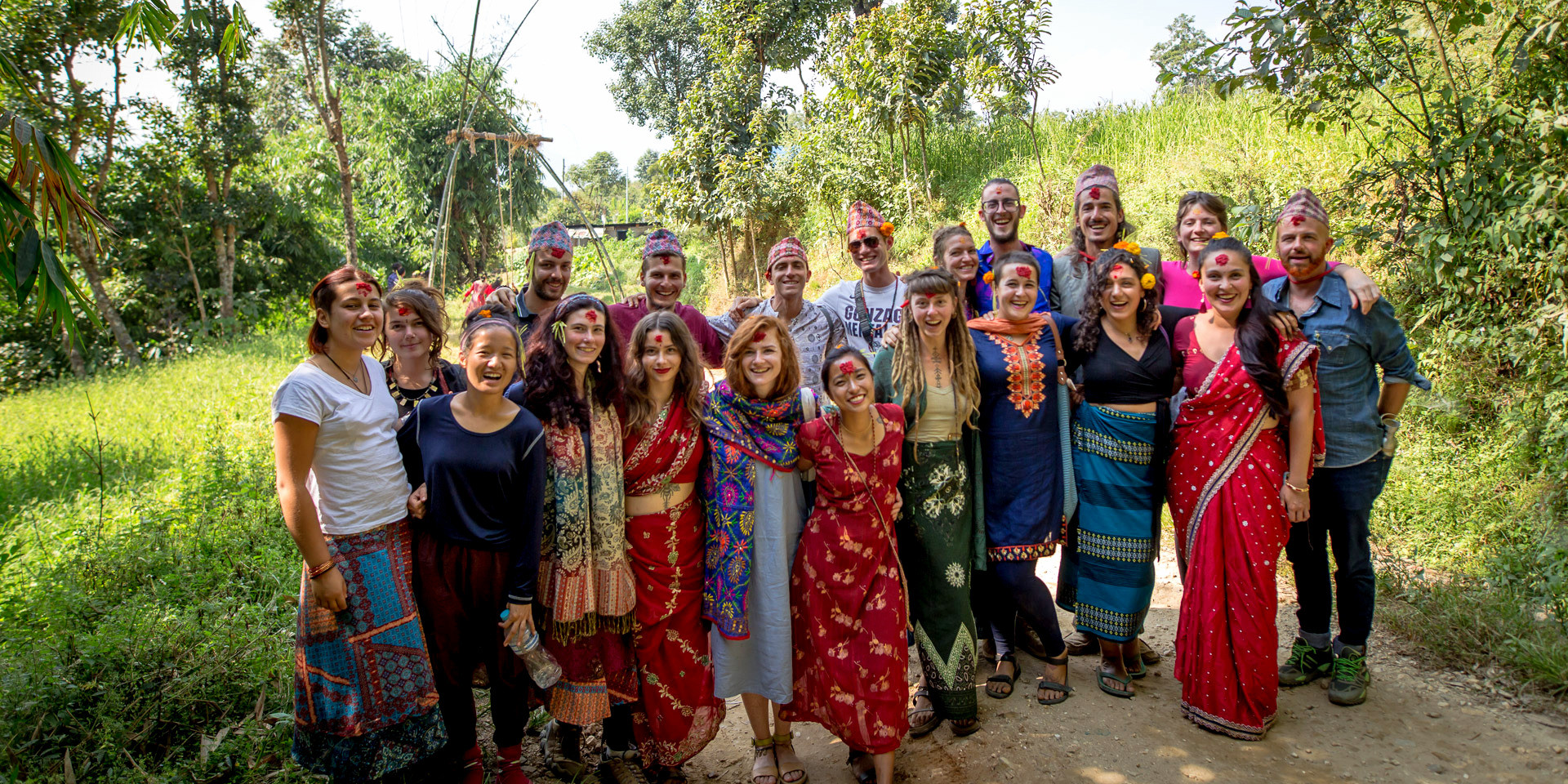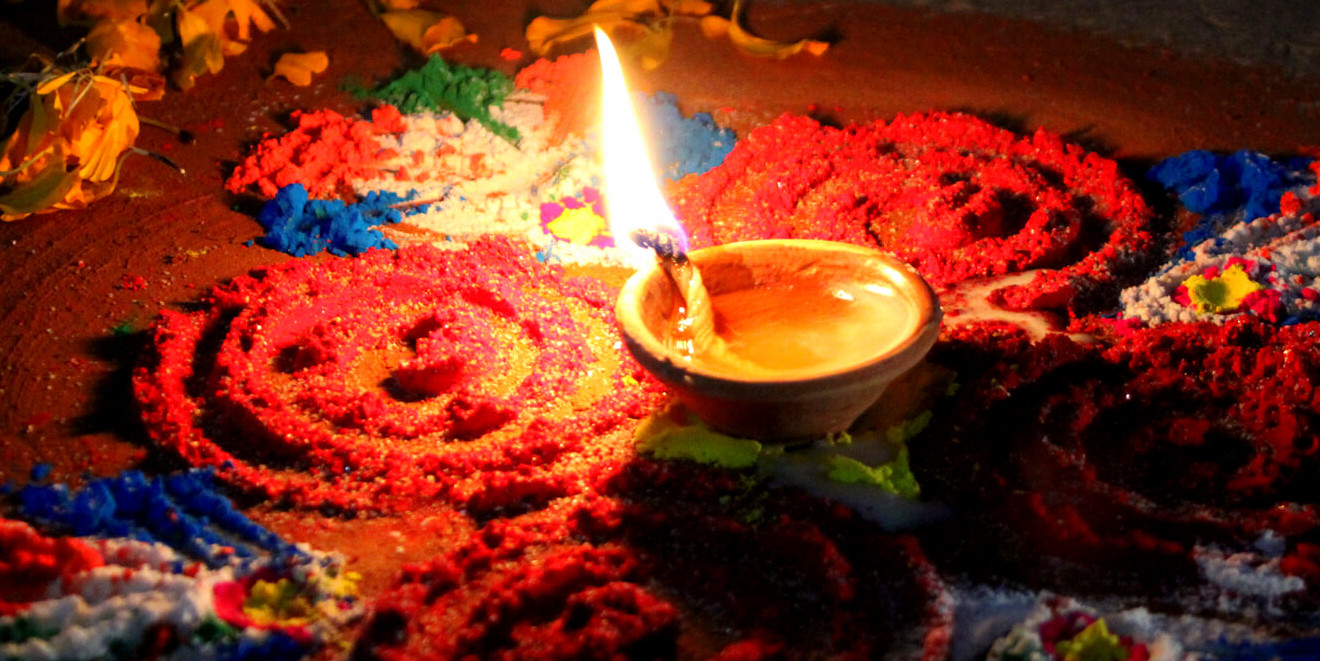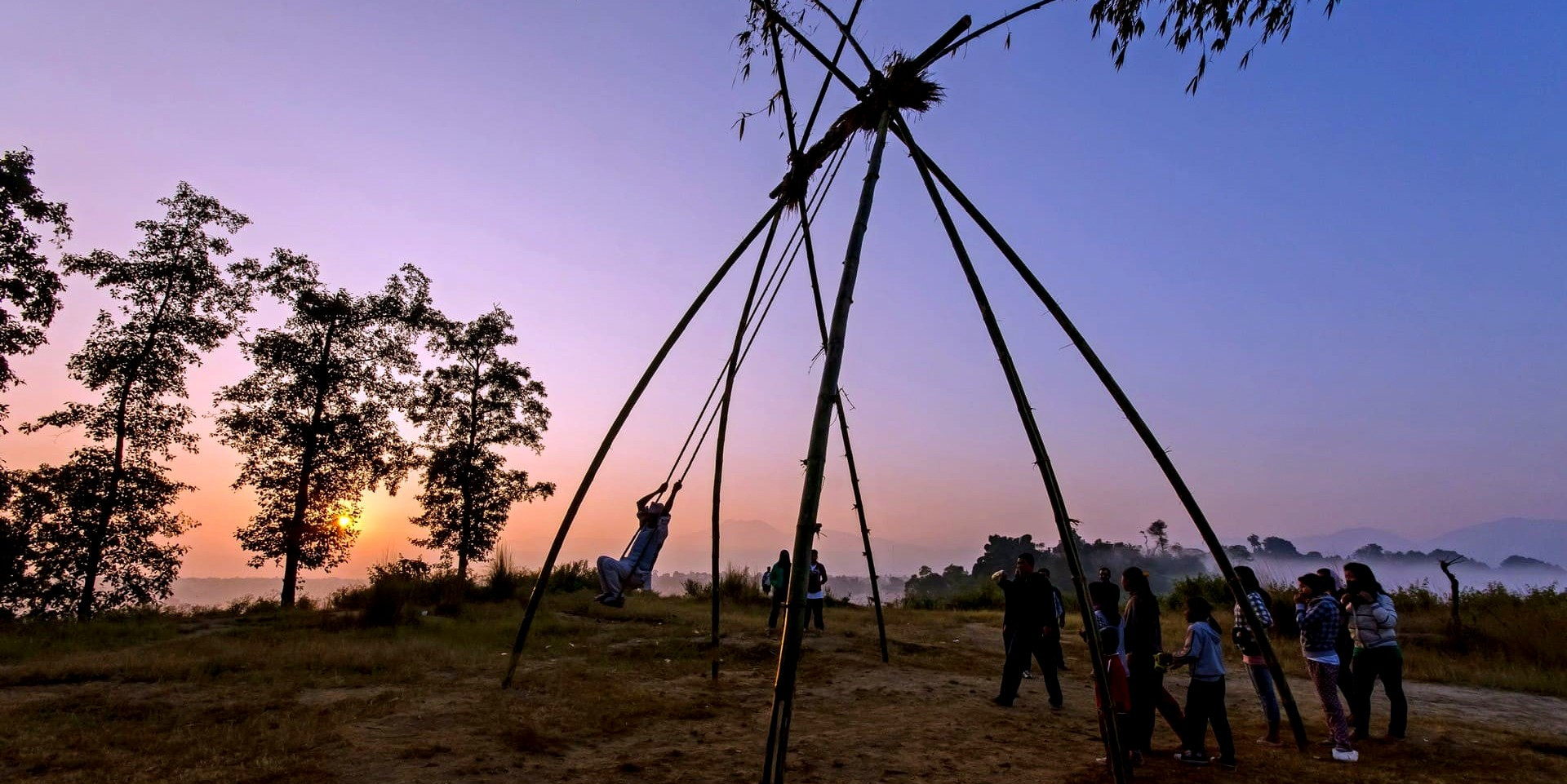Dashain Festival
The Dashain Festival is the most significant and longest festival in Nepal, deeply embedded in the cultural and religious fabric of the country. Celebrated by Nepalese people of all ages and backgrounds, Dashain symbolizes the victory of good over evil and is a time for family reunions, ritualistic worship, and communal festivity.

Origins and Significance: Dashain commemorates the victories of the goddess Durga over the buffalo demon Mahishasura. According to Hindu mythology, Durga, with her divine powers, fought Mahishasura for nine consecutive days and nights before finally defeating him on the tenth day, known as "Vijaya Dashami." This story symbolizes the triumph of good over evil and is celebrated widely across Nepal and in parts of India.
Key Rituals and Celebrations
-
Ghatasthapana: The festival begins with Ghatasthapana, the sowing of barley seeds in a pot of sand, which are then kept in a sacred room. The germination of these seeds is considered a sign of prosperity.
-
Fulpati: On the seventh day of the festival, a mixture of sacred leaves and flowers, known as Fulpati, is brought into the home in a ceremonial procession. This marks the divine presence in the household.
-
Maha Ashtami: The eighth day, or Maha Ashtami, sees the sacrifice of buffaloes and goats in temples dedicated to Durga. This day is one of intense ritual significance.
-
Nawami: The ninth day involves the worship of vehicles and machinery to bless them for safe operation throughout the year.
-
Vijaya Dashami: The tenth and most important day is Vijaya Dashami, where elders put tika (a mix of rice, yogurt, and vermilion) and jamara (sacred grass) on the foreheads of younger family members to bless them with prosperity and longevity. This ritual strengthens family bonds and is followed by large gatherings and feasts.
-
Kojagrat Purnima: The festival concludes on the full moon day, which emphasizes looking inward and seeking blessings from the goddess of wealth, Laxmi.
Cultural Impact: Dashain has a profound impact on the social and cultural life of Nepal. During this time, schools and offices are closed, allowing families to come together. People return to their home villages from all parts of the world, making it not just a religious observance but also a time for reunions.
Festive Activities
Beyond the rituals, Dashain is filled with activities that add to the celebratory atmosphere:
-
Kite Flying: Skies are dotted with kites as a symbol of calling the gods.
-
Card Games: Families and friends gather to play cards.
-
Shopping and Gifts: It's customary to buy new clothes and exchange gifts.
-
Swings: Bamboo swings (ping) are erected in many communities, providing joyous entertainment for children and adults alike.
Dashain not only embodies the spiritual ethos of Nepal but also reinforces family ties and social unity. It is a vivid example of Nepal's rich traditions and religious heritage, offering a deep insight into the lives and beliefs of its people. For anyone visiting Nepal during this festive season, Dashain provides a beautiful and powerful glimpse into the heart of Nepalese culture.
Tihar Festival
The Tihar Festival, also known as Deepawali or the festival of lights in Nepal, is a dazzling five-day event that follows closely after Dashain. It is marked by unique traditions that honor humans, gods, and animals, emphasizing themes of reverence, rejuvenation, and community bonding. Here are some of the key highlights of the Tihar Festival:

-
Kaag Tihar (Day of the Crows): Tihar begins with Kaag Tihar, where crows are worshipped by offering sweets and dishes on the rooftops. Crows are considered to be messengers in Hindu mythology, and this day is dedicated to appeasing them to avert grief and death in the house.
-
Kukur Tihar (Day of the Dogs): The second day of Tihar is Kukur Tihar, dedicated to honoring dogs for their loyalty and service. Dogs are adorned with garlands, offered delicious food, and a red tika is applied to their foreheads. This ritual underscores the deep respect for animals in Nepalese culture.
-
Gai Tihar and Laxmi Puja (Day of the Cows and Goddess Laxmi): On the third day, cows are worshipped in the morning during Gai Tihar. Cows hold a sacred place in Hinduism, symbolizing prosperity and wealth. In the evening, Laxmi, the Goddess of wealth, is worshipped. Homes are cleaned and decorated with lights and marigolds to welcome her, with the belief that Goddess Laxmi only enters clean and brightly lit homes.
-
Govardhan Puja (Day of the Oxen): Govardhan Puja is celebrated on the fourth day by making mounds of cow dung, which represent the mountain Govardhan that Lord Krishna lifted to protect the villagers from rain and floods. Oxen, which plow the fields, are also worshipped on this day.
-
Bhai Tika (Day of the Brothers): The final and most anticipated day of Tihar is Bhai Tika. Sisters apply a multicolored tika on their brothers' foreheads and pray for their long life and prosperity, while brothers give gifts in return. This day strengthens the bond between brothers and sisters and is accompanied by feasts and family gatherings.
-
Lights and Decorations: Throughout Tihar, homes and public spaces are illuminated with oil lamps, candles, and colorful lights. People also create intricate rangoli designs at entrances, which are meant to be artistic welcomes for gods and guests.
-
Deusi-Bhailo: During the evenings, groups of young people visit homes in their neighborhoods singing traditional songs and dancing (Deusi for boys, Bhailo for girls), in exchange for money, fruits, and sweets. This tradition is akin to caroling during Christmas and adds a lively communal atmosphere to the festivities.
-
Traditional Foods: Tihar is also a time for special dishes, including sweets and treats like sel roti (a rice flour donut), anarsa, and various types of mithai (sweets).
Tihar in Nepal is a beautiful expression of cultural richness and communal harmony, celebrating the cherished relationships between humans, animals, and divine entities with great fervor and joy.
Tips for Autumn Festivals in Nepal: Dashain and Tihar Celebrations
Experiencing the autumn festivals of Dashain and Tihar in Nepal is truly a unique and enriching cultural journey. Here are some essential tips to help you make the most of these vibrant celebrations if you're planning to visit Nepal during this festive season:
Plan Your Trip in Advance
- Accommodation and Transport: These festivals are among the busiest times in Nepal, with many locals traveling to their hometowns. Book your flights, accommodations, and local transport well in advance to avoid last-minute hassles and high prices.
Engage with Local Customs
- Participate in Traditions: Dashain and Tihar are excellent times to experience the warmth of Nepali hospitality. Participate in the local customs, try wearing traditional attire, and enjoy the communal feasts if invited.
Respect Religious Practices
- Understand the Significance: Both festivals have deep religious significance. Show respect by observing local rituals without intruding, and ask permission before taking photographs, especially during private or sensitive moments like animal sacrifices during Dashain.
Safety and Health
-
Stay Healthy: Street food is a big part of the festivals, but it's wise to eat from clean and reputable places to avoid stomach upsets. Also, carry hand sanitizers and maintain general hygiene.
-
Be Cautious of Crowds: Festive events can draw large crowds, so be mindful of your belongings and personal space.
Embrace the Festival of Lights
- Enjoy the Illuminations: During Tihar, the cities are beautifully lit up. Participate in lighting diyas (oil lamps), and appreciate the elaborate decorations and rangoli art made with colored powders and flowers.
Join in Community Activities
- Deusi-Bhailo and Kite Flying: Engage in singing Deusi-Bhailo or flying kites during Dashain. These activities are not only fun but also a great way to interact with locals and understand their culture better.
Learn About the Symbolism
- Educate Yourself: Understanding the stories and symbolism behind the rituals, such as why crows, dogs, and cows are worshipped during Tihar, will enrich your experience and give you deeper insights into Nepali culture.
Capture the Moments
- Photography: Both festivals offer vibrant photo opportunities—from the Tika ceremonies and kite flying to the dazzling lights of Tihar. Always ask for permission before taking photos to respect people’s privacy.
Weather Considerations
- Dress Appropriately: Autumn in Nepal can be a mix of warm days and chilly evenings. Pack accordingly, with layers that you can add or remove as needed. Rain can also be sporadic, so a lightweight waterproof jacket might come in handy.
Support Local Economy
- Shop Local: Festivals are a good time to support local artisans and businesses. Consider buying local crafts, clothes, and other goods as souvenirs or gifts.
By following these tips, you'll not only enjoy the rich tapestry of the Dashain and Tihar festivals but also contribute positively to the local communities, making your visit a memorable and respectful cultural exchange.
Rules and Regulations for Autumn Festivals in Nepal: Dashain and Tihar Celebrations
Visiting Nepal during the vibrant autumn festivals of Dashain and Tihar offers a spectacular glimpse into the country’s cultural and spiritual life. To ensure a respectful and enjoyable experience for both visitors and locals, it’s important to be aware of and adhere to certain rules and regulations that govern festival activities and public behavior during these times:
General Conduct
-
Respect Religious Sentiments: These festivals are deeply religious, so always show respect towards the rituals, deities, and worshippers. Avoid inappropriate behavior in temples and during ceremonies.
-
Dress Modestly: When attending festival events or visiting temples, dress conservatively. Avoid revealing clothing as a sign of respect in these culturally sensitive times.
-
Photography: Ask for permission before taking photos of people, especially during worship or private ceremonies. Be discreet and respectful when capturing images during animal sacrifices or other sensitive rituals.
Participation in Rituals and Events
-
Engagement in Rituals: While many Nepalis are welcoming and may invite you to participate in rituals like tika application or lighting diyas, always participate with a clear understanding of what the ritual entails and follow the lead of your hosts.
-
Handling of Offerings and Prasad: Handle any food or offerings (prasad) given during the festivals with care. It is considered sacred, and there are often specific ways to accept and consume it respectfully.
Environmental Considerations
-
Use of Fireworks and Firecrackers: Be cautious with fireworks and firecrackers during Tihar, as there are often regulations in place to prevent noise pollution and ensure public safety.
-
Littering: With the increase in festivity and public gatherings, there’s a tendency for more litter. Always dispose of waste properly and use designated bins for offerings and other disposables to keep the environment clean.
Public Safety and Legal Compliance
-
Alcohol Consumption: Public intoxication can be frowned upon, especially during religious festivities. If you consume alcohol, do so responsibly and in appropriate settings.
-
Animal Sacrifice: The practice of animal sacrifice during Dashain is traditional but can be unsettling for some visitors. Be prepared for this aspect of the festival, and respect local customs even if you choose not to witness these rites.
-
Traffic and Road Safety: Traffic can increase significantly during the festivals, with many people traveling to and from their hometowns. Be cautious when driving, and observe local traffic laws and advisories.
Cultural Sensitivity
-
Interaction with Locals: Nepalis are generally hospitable and friendly, especially during festivals when the spirit of community is strong. Engage with locals in a friendly manner, and be open to learning about their traditions and sharing your own.
-
Gifts and Tipping: Offering small gifts or tips, especially to children or performers during Deusi-Bhailo, is common but not mandatory. Small denominations of money or sweets are typical gifts.
Understanding and respecting these rules and regulations during the Dashain and Tihar festivals will not only enhance your experience but also help preserve the sanctity and tradition of these important cultural events in Nepal.
The autumn festivals of Dashain and Tihar in Nepal offer a vivid window into the cultural and spiritual life of the country. These celebrations are more than just seasonal festivities; they are a deep expression of community bonding, spiritual renewal, and cultural immersion. Dashain emphasizes familial blessings and societal renewal, while Tihar dazzles with lights and honors the bonds between humans, gods, and animals. Together, these festivals provide a profound opportunity for both locals and visitors to engage in traditions that reflect the values of respect, kinship, and reverence embedded in Nepali culture. For anyone eager to experience the essence of Nepal, participating in these rich autumnal festivities is truly unparalleled.
FAQs for Autumn Festivals in Nepal: Dashain and Tihar Celebrations
Q: What are Dashain and Tihar?
A: Dashain is the longest and most significant Hindu festival in Nepal, celebrating the victory of goddess Durga over evil. It involves various rituals, family gatherings, and blessings. Tihar, also known as the festival of lights, follows Dashain and involves worshipping different animals and the goddess Laxmi, and celebrating the bond between brothers and sisters.
Q: When are Dashain and Tihar celebrated?
A: Dashain usually takes place in September or October, aligning with the lunar calendar. It lasts for 15 days. Tihar occurs shortly after Dashain in October or November and spans five days.
Q: What are the main activities during Dashain?
A: During Dashain, key activities include the sowing of Jamara (sacred barley shoots), receiving Tika and blessings from elders, flying kites, playing on swings, and participating in animal sacrifices.
Q: How is Tihar celebrated differently from Dashain?
A: Tihar is distinguished by its emphasis on lights and decoration. Each day of Tihar is dedicated to honoring a different entity: crows, dogs, cows, oxen, and finally, brothers during the Bhai Tika ceremony. Homes are decorated with lights, candles, and colorful patterns made of flowers and colored powders.
Q: What should visitors expect in terms of public participation?
A: Visitors are often warmly welcomed to participate in both festivals. You can expect to see large gatherings, special performances, and public displays of rituals. Participating in community events can provide deeper insights into Nepali culture.
Q: Are there specific customs or dress codes for these festivals?
A: While there is no strict dress code, modest and culturally sensitive attire is recommended, especially when participating in rituals or visiting temples. Wearing traditional Nepali clothing can be a respectful and appreciated gesture.
Q: What are the dos and don'ts during Dashain and Tihar?
A: Do: Participate respectfully, ask permission before taking photographs, and engage with local customs and traditions. Don't: Intrude on private family gatherings without an invitation, disrespect the religious aspects of the festivals, or consume alcohol excessively.
Q: Can tourists take part in the Tika ceremonies during Dashain?
A: While Tika ceremonies are generally family-oriented, many local communities warmly welcome tourists to observe or even participate. Always approach such invitations with respect and gratitude.
Q: What should visitors know about the use of fireworks during Tihar?
A: While fireworks are common during Tihar, it's important to use them responsibly due to safety concerns and local regulations that might limit their use in certain areas.
Q: How can visitors contribute positively to the festivals?
A: Supporting local artisans by purchasing local goods, respecting cultural practices, and maintaining cleanliness during the festivals are excellent ways to contribute positively.
For detail on Nepal Tour.
If you are looking for different kinds of Nepal Packages, feel free to contact us.




